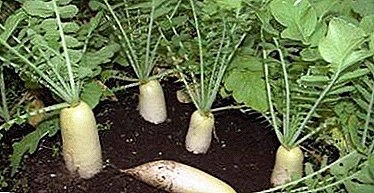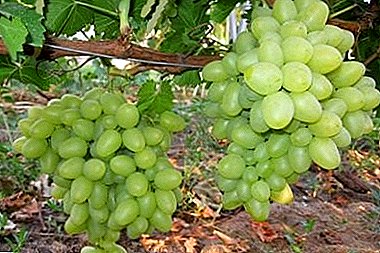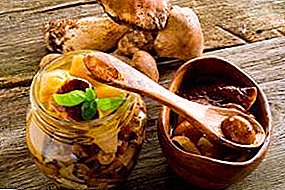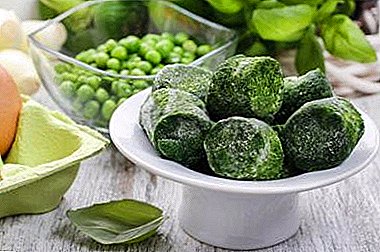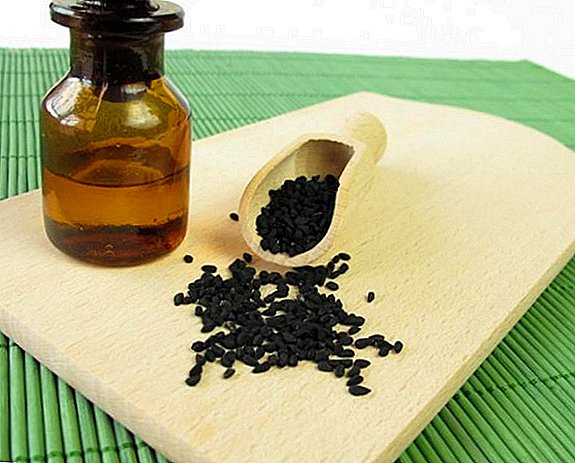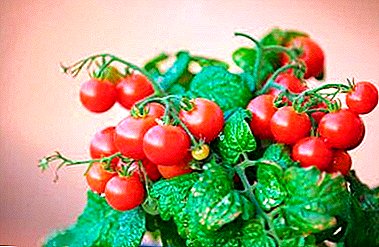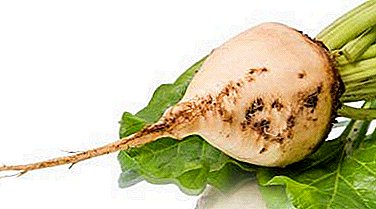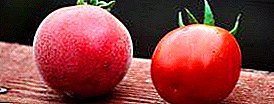
For lovers of large-fruited pink tomatoes there is a very good hybrid variety of tomato "Apricot", this is a guest from Lithuania. During his history in Russia, he managed to earn credibility.
The description of the variety of tomatoes "Apricot" F1, characteristics, yield and merit and will be discussed in our article.
Apricot Tomato F1: variety description
 Tomato "Apricot" F1 - is a mid-season hybrid, from planting seedlings to ripening first fruits will have to wait 105-110 days. The plant is indeterminate, standard, rather tall 140-180 cm.
Tomato "Apricot" F1 - is a mid-season hybrid, from planting seedlings to ripening first fruits will have to wait 105-110 days. The plant is indeterminate, standard, rather tall 140-180 cm.
This type of tomato is recommended for growing in greenhouses and in the open field. It has a high resistance to cracking of fruits and tobacco mosaic, as well as to other types of diseases.
Mature fruits have pink or dark pink color, they are dense, fleshy. The shape is rounded. In accordance with the description of tomato varieties, the tomato "Apricot" has the largest fruit of pubescent representatives, the weight of the fruit varies from 350 to 500 grams.
The number of chambers 4-5, the solids content of 5-6%. Harvested fruits can be stored for a long time and tolerate transportation. Farmers who grow tomatoes for sale in large volumes fell in love with his product quality.
You can compare the weight of the fruit with other varieties below:
| Grade name | Fruit weight |
| Apricot | 350-500 grams |
| Riddle | 75-110 grams |
| Big Mama | 200-400 grams |
| Banana feet | 60-110 grams |
| Petrusha gardener | 180-200 grams |
| Honey saved | 200-600 grams |
| King of beauty | 280-320 grams |
| Pudovik | 700-800 grams |
| Persimmon | 350-400 grams |
| Nikola | 80-200 grams |
| Right size | 300-800 |
 Read more about the diseases of tomatoes in greenhouses in the articles of our website, as well as methods and measures to combat them.
Read more about the diseases of tomatoes in greenhouses in the articles of our website, as well as methods and measures to combat them.You can also get acquainted with information about high-yielding and disease-resistant varieties, about tomatoes that are not at all prone to phytophthora.
Specifications
Tomato "Apricot" was bred in Latvia by Riga specialists in 1999, received registration in Russia as a hybrid variety recommended for greenhouse shelters and unprotected soil, received in 2002. Since that time, it has enjoyed steady popularity among amateurs and farmers for its high marketable qualities.
For the cultivation of tomatoes "Apricot" F1 in the open field is more suitable southern regions of Russia. In the middle lane, it is permissible to grow this hybrid variety under film covers. But in more northern areas, the use of heated greenhouses is recommended, since the Abrikos tomato practically does not tolerate the summer temperature drops in these latitudes.
Because of their massiveness, the Apricot F1 tomatoes are not suitable for whole-canning, but they can be used in barrel pickles. Tomatoes of this type will be very good fresh. Many lovers say that they make very good juice and pasta.
With proper care and good conditions, this species can give up to 3-5 kg per bush.. With a recommended planting density of 4 bushes per square meter. m, you can collect an average of 18 kg. This is a very good indicator of yield. Compare it with other varieties can be in the table:
| Grade name | Yield |
| Apricot | 3-5 kg from a bush |
| Lazy man | 15 kg per square meter |
| Rocket | 6.5 kg per square meter |
| Summer resident | 4 kg from a bush |
| Prime minister | 6-9 kg per square meter |
| Doll | 8-9 kg per square meter |
| Stolypin | 8-9 kg per square meter |
| Broody | 10-11 kg per square meter |
| Black bunch | 6 kg from a bush |
| Fat jack | 5-6 kg from a bush |
| Buyan | 9 kg from a bush |
Advantages and disadvantages
Among the main advantages of this hybrid note:
- fruit taste;
- good yield;
- resistance to temperature extremes;
- the duration of fruiting.
Among the minuses of "Apricot", some, especially newcomers, point out the weakness of the trunk and branches, which need additional support, otherwise the branches break off.
Features of growing
Among the features of this hybrid is to provide large-fruited and duration of fruiting. You can also say about its resistance to temperature extremes and resistance to diseases.
The trunk and branches of the bush due to high growth need garters and props. Shrub is most often formed in two or three stems, but preferably in three. At the stage of development and growth strongly needs complex feedings.
- Organic, mineral, phosphoric and ready-made fertilizers for seedlings and TOP best.
- Yeast, iodine, ammonia, hydrogen peroxide, ash, boric acid.
- What is foliar feeding and fertilizer when picking.
Diseases and pests
 Most often, "Apricot" is subject to fitoftor, especially when it is grown in open ground. To combat this disease at the initial stage, use the tool "Barrier".
Most often, "Apricot" is subject to fitoftor, especially when it is grown in open ground. To combat this disease at the initial stage, use the tool "Barrier".
If the disease has entered a deeper stage, then the “Barrier” tool should be used. In case of fomozom disease, it is necessary to remove the affected fruits, and then treat the bushes with the drug "Khom".
The sucker miner can also infect a plant, and the Bison should be used against it. In the more southern regions, one should be wary of a rusty mite, the Bison drug will be effective against it.
Conclusion
As follows from the general review, this is not a very difficult to care for variety. If you follow the simple rules of care, you can get a very good result. Good luck and great harvest.
| Medium early | Superearly | Mid-season |
| Ivanovich | Moscow stars | Pink Elephant |
| Timofey | Debut | Crimson onslaught |
| Black truffle | Leopold | Orange |
| Rosaliz | President 2 | Bull forehead |
| Sugar giant | The miracle of cinnamon | Strawberry dessert |
| Orange giant | Pink Impreshn | Snow tale |
| Stopudov | Alpha | Yellow ball |


